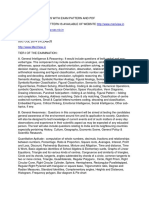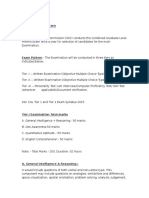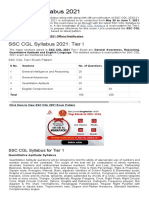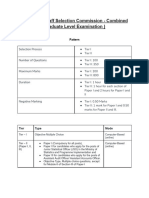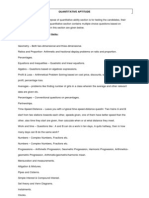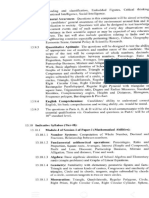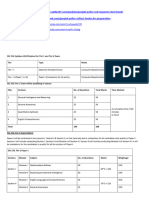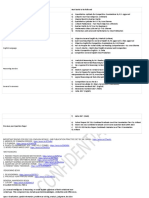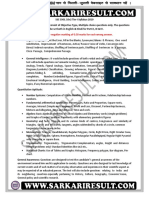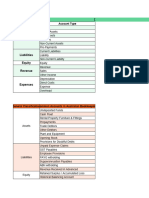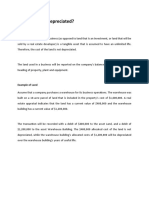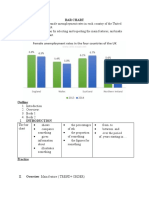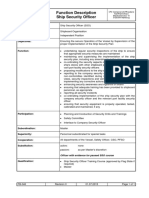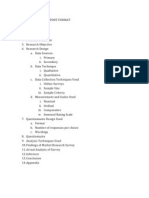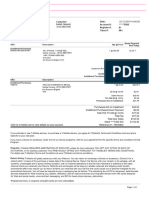SSC CGL Syllabus 2020
SSC CGL Tier 1 Syllabus
The first stage of SSC CGL Recruitment Exam is the Tier 1 Level. It will have an Online
mode of examination and questions will be of objective type. The Sections under the
SSC CGL Tier I are mentioned in the Table below. There are 4 sections in SSC CGL -
1. General Intelligence And Reasoning
2. General Awareness
3. Quantitative Aptitude
4. English Language And Comprehension
General Intelligence And Reasoning
It is one of the scoring sections in SSC CGL exam.This section includes both verbal and
non verbal reasoning. Let us understand in detailed syllabus of General Intelligence and
Reasoning .
1|P ag e
�The non verbal reasoning consists of topics such as cubes and dices, mirror/water
images , paper folding ,coding decoding, syllogism, classification , Blood relation ,
Direction and Distance, emotional and social intelligence
General Awareness
Questions in this component will be aimed at testing the candidates general awareness
of the environment around him and its application to society. Questions will also be
designed to test knowledge of current events and of such matters of everyday
observations and experience in their scientific aspect as may be expected of any
educated person.
The test will also include questions relating to India and its neighbouring countries
especially pertaining to
2|P ag e
�Sports
History (Ancient, Medieval and Modern)
Culture
Geography
Economic Scene
General Polity
Indian Constitution
Scientific Research
Though the official doesn’t prescribe the topics to learn under the above mentioned
subjects but based on previous year trends the frequently asked topics are compiled.
History Geography Economy Biology
Ancient History India and Budget Related Plant Kingdom,
(Harappan Neighbouring Terms,Laws Of Demand Animal Kingdom.
Civilization Countries,Solar Supply,Inflation,Sectors Of Human Body and
Vedic Culture,) System,Famous Economy,International Diseases,
Medieval Sea Port, Organisation Environmental
History and Rivers,Important Studies
Modern History Institution.
(British Rule
and Gandhian
Era)
Polity Physics Computers Chemistry
3|P ag e
�Indian SI Unit, Light and Basic Facts Properties Of
Constitutions, Reflection,Electricity,Wave About Substances,Chemical
Duties and Optics,Motion Computers, Reactions,Properties
Facts Related Recent Of Gases,
To President , Developments ChemistryIn Day To
Chief Minister, in Technology Day Life.
Prime Minister,
CAG,
Panchayati Raj
System,Indian
Parliament.
Quantitative Aptitude
The questions will be designed to test the ability of appropriate use of numbers and
number sense of the candidate. The scope of the test will be the computation of whole
numbers, decimals and fractions and relationships between numbers. It will test sense
of order among numbers, ability to translate from one name to another, sense or order
of magnitude, estimation or prediction of the outcome of computation, selection of an
appropriate operation for the solution of real life problems and knowledge of alternative
computation procedures to find answers. The questions would also be based on
arithmetical concepts and relationship between numbers and not on complicated
arithmetical computation (The standard of the questions will be of 10+2 level).
The generally asked under various sections of Quantitative Aptitude are as follows-
4|P ag e
� Quantitative Aptitude
Arithmetic Algebra Geometry
1. Percentage 1. Surds And 1. Similarity Of Triangles
Indices
2. Profit And Loss 2. Basic 2. Circles
Elementary Level
Algebra
3. Ratio And 3. Graphs and Linear 3.Properties Related To Various
Proportion Equation Geometrical Figures ( Polygon,
Cylinder, Sphere)
4. Average
Time And Distance
Time And Work
Mixture And Alligation
Simple and
Compound Interest
Probability
Permutation and
Combinations
Mensuration Data Interpretation Trigonometry
(DI)
2D and 3D Histograms, Pie Basic Trigonometric Properties , Heights
5|P ag e
�Mensuration Chart, And Distances
English Comprehension and Language
Candidates’ ability to understand correct English, their basic comprehension and writing
ability, etc. would be tested.(The questions in the components A,B & D will be of a level
commensurate with the Essential Qualification prescribed for the post viz; graduation).
SSC CGL Tier 2 Syllabus
Paper 1 - Arithmetic Ability
The Arithmetic Ability consists of topics similar to the quantitative aptitude of Tier 1
level. Though the level of questions asked in SSC CGL tier 2 will be higher than tier 1. .
The topics to be asked in this section includes
6|P ag e
� Arithmetic Ability
Whole Numbers Decimals and Fractions
Fundamental Arithmetic Operations Percentage
Ratio And Proportion Average
Profit And Loss Discount
Tables and Graphs Mensuration
Time And Distance Ratio And Time
Paper 2 -English Language & Comprehension
Questions in this components will be designed to test the candidate’s understanding
and knowledge of English Language and will be based on error recognition, fill in the
blanks (using verbs, preposition, articles etc), Vocabulary, Spellings, Grammar,
Sentence Structure, Synonyms, Antonyms, Sentence Completion, Phrases and
Idiomatic use of Words, etc. There will be a question on passages and comprehension
of passages also. (The standard of the questions will be of 10+2 level).
English Language & Comprehension Topics
Vocabulary Grammar
Antonyms Sentence Completion
Sentence Structure Synonyms
Phrases and Idioms Spellings
7|P ag e
�Commerce/Mathematics/Statistics/Economics for Investigator Grade-II, for Ministry of
Statistics & Programme Implementation and Compiler for Registrar General of India,
Ministry of Home Affairs.
Paper 3 - Statistics ( Junior Statistical Officer)
The syllabus for Statistics Paper is given below-
Probability Probability Distributions, Binomial, Poisson, Normal, Exponential.
Compilation classification, tabulation of Statistical Data, Graphical presentation of data.
Measures of central tendency, measures of dispersion, measures of association and
contingency, scatter diagram, correlation coefficient, rank correlation coefficient and
linear regression analysis ( for two or more variables ) excluding partial correlation
coefficients.
Concept of Population, random sample, parameters, statistics, sampling distribution of
x properties of estimators and estimation of confidence intervals.
Principles of sampling, simple random sampling, stratified sampling, systematic
sampling etc., Sampling and non-sampling errors, type-I and type-II errors
Concepts of Hypothesis – Null and alternate, Testing of hypothesis for large samples
as well as small samples including Chi-square tests ( Z, t, F, 2 tests ).
Index Numbers, Time series analysis – components of variation and their estimation.
Paper-IV: General Studies-Finance and Economics (Assistant Audit Officer/
Assistant Accounts Officer)
Fundamental principles and basic concept of Accounting:
Financial Accounting: Nature and scope, Limitations of Financial Accounting,
Basic concepts and Conventions, Generally Accepted Accounting Principles.
8|P ag e
� Basic concepts of accounting: Single and double entry, Books of original
Entry, Bank Reconciliation, Journal, ledgers, Trial Balance, Rectification of
Errors, Manufacturing, Trading, Profit & loss Appropriation Accounts, Balance
Sheet Distinction between Capital and Revenue Expenditure, Depreciation
Accounting, Valuation of Inventories, Non-profit organisations Accounts, Receipts
and Payments and Income & Expenditure Accounts, Bills of Exchange, Self
Balancing Ledgers.
Part B: Economics and Governance - (120 marks)
Comptroller & Auditor General of India - Constitutional provisions, Role and
responsibility
Finance Commission - Role and functions
Basic Concept of Economics and introduction to Microeconomics -
Definition, scope and nature of Economics, Methods of economic study and
Central problems of an economy and Production possibilities curve
Theory of Demand and Supply - Meaning and determinants of demand, Law of
demand and Elasticity of demand, Price, income and cross elasticity; Theory of
consumer’s behaviour - Marshallian approach and Indifference curve approach,
Meaning and determinants of supply, Law of supply and Elasticity of Supply.
Theory of Production and cost - Meaning and Factors of production; Laws of
production- Law of variable proportions and Laws of returns to scale.
Forms of Market and price determination in different markets - Various
forms of markets - Perfect Competition, Monopoly, Monopolistic Competition and
Oligopoly ad Price determination in these markets
Theory of Demand and Supply - Meaning and determinants of demand, Law of
demand and Elasticity of demand, Price, income and cross elasticity; Theory of
consumer’s behaviour - Marshallian approach and Indifference curve approach,
Meaning and determinants of supply, Law of supply and Elasticity of Supply.
Theory of Production and cost - Meaning and Factors of production; Laws of
production- Law of variable proportions and Laws of returns to scale.
Forms of Market and price determination in different markets - Various
forms of markets - Perfect Competition, Monopoly, Monopolistic Competition and
Oligopoly ad Price determination in these markets.
Economic Reforms in India - Economic reforms since 1991; Liberalisation,
Privatisation, Globalisation and Disinvestment
Indian Economy –
1. Nature of the Indian Economy Role of different sectors - Role of Agriculture,
Industry and Services-their problems and growth;
9|P ag e
� 2. National Income of India - Concepts of national income, Different methods of
measuring national income
3. Population - Its size, rate of growth and its implication on economic growth
4. Poverty and unemployment - Absolute and relative poverty, types, causes and
incidence of unemployment
5. Infrastructure - Energy, Transportation, Communication
Money and Banking -
1. Monetary/ Fiscal policy - Role and functions of Reserve Bank of India; functions
of commercial Banks/ RRB/ Payment Banks
2. Budget and Fiscal deficits and Balance of payments
3. Fiscal Responsibility and Budget Management Act, 2003
Role of Information Technology in Governance
SSC CGL Tier 3 Syllabus
The SSC CGL Tier 3 Syllabus consists of Descriptive Paper which includes Letter
Writing and Application Writing. Letter writing includes both formal letter (letter to editor,
letter to municipality etc) and informal letter ( letter to friend etc)
SSC CGL Tier 4 Syllabus
There is no syllabus for Tier 4 Exam. SSC CGL Tier 4 consists of Document Verification
and Data Entry Skill Test (DEST)/ Computer Proficiency Test (CPT)
10 | P a g e







